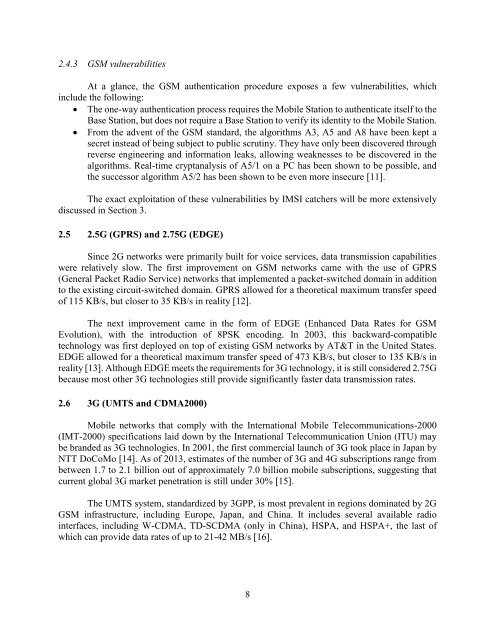IMSI Catchers and Mobile Security
EAS499Honors-IMSICatchersandMobileSecurity-V18F-1
EAS499Honors-IMSICatchersandMobileSecurity-V18F-1
Create successful ePaper yourself
Turn your PDF publications into a flip-book with our unique Google optimized e-Paper software.
2.4.3 GSM vulnerabilities<br />
At a glance, the GSM authentication procedure exposes a few vulnerabilities, which<br />
include the following:<br />
The one-way authentication process requires the <strong>Mobile</strong> Station to authenticate itself to the<br />
Base Station, but does not require a Base Station to verify its identity to the <strong>Mobile</strong> Station.<br />
From the advent of the GSM st<strong>and</strong>ard, the algorithms A3, A5 <strong>and</strong> A8 have been kept a<br />
secret instead of being subject to public scrutiny. They have only been discovered through<br />
reverse engineering <strong>and</strong> information leaks, allowing weaknesses to be discovered in the<br />
algorithms. Real-time cryptanalysis of A5/1 on a PC has been shown to be possible, <strong>and</strong><br />
the successor algorithm A5/2 has been shown to be even more insecure [11].<br />
The exact exploitation of these vulnerabilities by <strong>IMSI</strong> catchers will be more extensively<br />
discussed in Section 3.<br />
2.5 2.5G (GPRS) <strong>and</strong> 2.75G (EDGE)<br />
Since 2G networks were primarily built for voice services, data transmission capabilities<br />
were relatively slow. The first improvement on GSM networks came with the use of GPRS<br />
(General Packet Radio Service) networks that implemented a packet-switched domain in addition<br />
to the existing circuit-switched domain. GPRS allowed for a theoretical maximum transfer speed<br />
of 115 KB/s, but closer to 35 KB/s in reality [12].<br />
The next improvement came in the form of EDGE (Enhanced Data Rates for GSM<br />
Evolution), with the introduction of 8PSK encoding. In 2003, this backward-compatible<br />
technology was first deployed on top of existing GSM networks by AT&T in the United States.<br />
EDGE allowed for a theoretical maximum transfer speed of 473 KB/s, but closer to 135 KB/s in<br />
reality [13]. Although EDGE meets the requirements for 3G technology, it is still considered 2.75G<br />
because most other 3G technologies still provide significantly faster data transmission rates.<br />
2.6 3G (UMTS <strong>and</strong> CDMA2000)<br />
<strong>Mobile</strong> networks that comply with the International <strong>Mobile</strong> Telecommunications-2000<br />
(IMT-2000) specifications laid down by the International Telecommunication Union (ITU) may<br />
be br<strong>and</strong>ed as 3G technologies. In 2001, the first commercial launch of 3G took place in Japan by<br />
NTT DoCoMo [14]. As of 2013, estimates of the number of 3G <strong>and</strong> 4G subscriptions range from<br />
between 1.7 to 2.1 billion out of approximately 7.0 billion mobile subscriptions, suggesting that<br />
current global 3G market penetration is still under 30% [15].<br />
The UMTS system, st<strong>and</strong>ardized by 3GPP, is most prevalent in regions dominated by 2G<br />
GSM infrastructure, including Europe, Japan, <strong>and</strong> China. It includes several available radio<br />
interfaces, including W-CDMA, TD-SCDMA (only in China), HSPA, <strong>and</strong> HSPA+, the last of<br />
which can provide data rates of up to 21-42 MB/s [16].<br />
8



